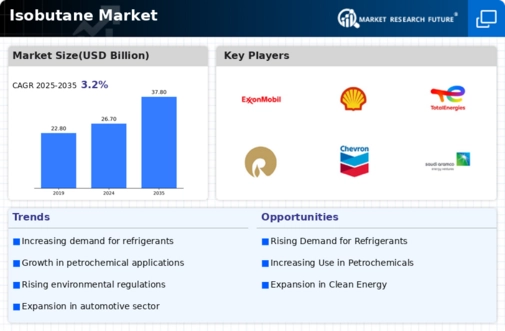Growth in Refrigerant Applications
The Isobutane Market is witnessing a substantial growth in the use of isobutane as a refrigerant, particularly in the HVAC and refrigeration sectors. With the ongoing transition towards environmentally friendly refrigerants, isobutane has emerged as a preferred choice due to its low global warming potential and high energy efficiency. The adoption of isobutane in refrigeration systems aligns with international efforts to phase out harmful substances like hydrofluorocarbons (HFCs). Market data reveals that the use of isobutane in refrigeration applications is expected to expand, driven by regulatory changes and increasing consumer awareness regarding sustainable practices. This trend is likely to enhance the overall growth of the Isobutane Market.
Expanding Use in Personal Care Products
The Isobutane Market is also benefiting from the expanding use of isobutane in personal care and cosmetic products. Isobutane is commonly utilized as a propellant in aerosol formulations, including hair sprays, deodorants, and other personal care items. The increasing consumer preference for convenient and effective personal care solutions is propelling the demand for aerosol products, thereby driving the need for isobutane. Recent market analysis indicates that the personal care segment is one of the fastest-growing applications for isobutane, with a projected growth rate that outpaces other sectors. This trend underscores the versatility of isobutane and its integral role in the Isobutane Market.
Rising Demand in Petrochemical Industry
The Isobutane Market is experiencing a notable surge in demand, primarily driven by its extensive application in the petrochemical sector. Isobutane serves as a crucial feedstock for the production of various chemicals, including isooctane, which is a key component in high-octane gasoline. As the automotive industry continues to evolve, the need for cleaner and more efficient fuels is becoming paramount. Consequently, the demand for isooctane, derived from isobutane, is projected to increase, thereby bolstering the isobutane market. Recent data indicates that the global consumption of isobutane in petrochemical applications has risen significantly, suggesting a robust growth trajectory for the Isobutane Market in the coming years.
Technological Innovations in Production
Technological advancements in the production of isobutane are playing a pivotal role in shaping the Isobutane Market. Innovations in extraction and refining processes are enhancing the efficiency and yield of isobutane production. For instance, the development of advanced catalytic processes has the potential to reduce production costs and improve the overall sustainability of isobutane manufacturing. As companies invest in state-of-the-art technologies, the market is likely to witness increased competition and improved product quality. Furthermore, these advancements may lead to a more stable supply chain, addressing potential shortages and fluctuations in pricing. Thus, technological innovations are expected to significantly influence the growth trajectory of the Isobutane Market.
Increasing Focus on Sustainable Practices
The Isobutane Market is increasingly influenced by the global shift towards sustainable practices. As industries strive to reduce their carbon footprint, the demand for eco-friendly alternatives is on the rise. Isobutane, with its lower environmental impact compared to traditional hydrocarbons, is gaining traction as a sustainable option in various applications. This trend is particularly evident in sectors such as automotive fuels and refrigerants, where regulatory pressures are prompting companies to adopt greener solutions. Market data suggests that the emphasis on sustainability is likely to drive innovation and investment in the isobutane sector, fostering growth within the Isobutane Market. As consumers become more environmentally conscious, the demand for sustainable products, including those utilizing isobutane, is expected to increase.

















Leave a Comment